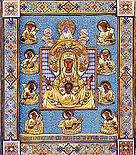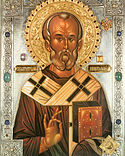The Contemporary Canonical Status of the Russian Church
The Contemporary Canonical Status of the Russian Church
(The ideas presented here are adapted from the report “Decree No. 362 and Church Districts” presented at the 6th All-Diaspora Council in January 2017.)
1. The Supreme Church Administration
The basic principles of the canonical structure of the Russian Church were established by the Local Council in 1917. In accord with its decision, supreme authority in the Russian Church is vested in the Local Council, which convenes every three years. The Local Council elects the Holy Patriarch (for life), the Holy Synod and the Supreme Church Council (members of the Holy Synod and of the Supreme Church Council are elected for three year terms).
The Holy Patriarch together with the Holy Synod and the Supreme Church Council comprise the Supreme Church Administration (SCA) of the Russian Church.
In 1927 the Bolsheviks, acting through Metropolitan Sergey (Stragorodskiy), succeeded in completely subordinating the SCA of the Russian Church. Since then, the canonical SCA has ceased to exist.
Until there is the possibility of convening a canonical Local Council, the Russian Church does not have any Supreme Church Authority.
2. Decree No. 362
On November 20, 1920 the SCA chaired by the Holy Patriarch Tikhon issued a Resolution (Decree) No. 362 that provided guidance on how the Russian Church must be canonically organized in the event that the SCA ceases operation. As we do not recognize the church leadership of the Moscow Patriarchate, Decree No. 362 is currently the canonical basis upon which the Russian Church exists.
The goal of this decree was to prevent the atomization of the Russian Church in the absence of the SCA. To this end, Decree No. 362 instructed bishops of neighboring dioceses to form temporarily autonomous Church Districts lead by the senior bishop. However, the Decree did not require that everyone subordinate themselves to one church center, that is, the possibility of forming a temporary alternative SCA for all Russian dioceses was not envisioned. The decree also said nothing about the possibility of one Church District subordinating itself to another Church District.
Therefore, according to the authors of Decree No. 362,one Russian Church, in the absence of a canonical SCA, should consist of a group of administratively autonomous Church Districts that are united spiritually and in Eucharistic communion in one Church.
It is obvious that this situation will continue until such time that the restoration of the Russian Church SCA is possible.
3. The Church Abroad
The canonical basis of the ROCA according to the Regulations of ROCA is Decree No. 362. But it must be noted that the ROCA was organized before the existence of Decree No. 362 became known abroad. As a result the structure of ROCA is different than the concept described in Decree No. 362. The ROCA at its establishment was premised on the essential need to have a central administrative center for all Russian dioceses abroad. In addition, it was assumed that a Supreme Church Administration, centered abroad and free from the Bolsheviks, if necessary could lead the whole Russian Church from abroad.
However, this idea of creating an alternative SCA, which would take over the management of the Church in the event that the SCA in Russia ceased to function, cannot be found in Decree No. 362. Andlater on, this idea was not approved by St. Patriarch Tikhon.
The over 80-year history of the ROCA shows that the ROCA structure established by Metropolitan Antoniy (Khrapovitskiy) was, for its time, vital and beneficent for the Russian Church.
But in today’s circumstances, the idea of a single church center is harmful. This idea does not foster unity but, on the contrary, leads to rivalry and division in the Church.
It is time to return to the concept of St. Patriarch Tikhon’s Decree, to administratively separate Church Districts that are united spiritually and in Eucharistic communion, and who together make up one Russian Church.
4. Succession from ROCA
As mentioned above, the establishment of the original ROCA was not quite consistent with Decree No.362. However, other than Decree No. 362, there are no other documents of the Supreme Church Authority that sanction the existence of the ROCA. Therefore, from a formal legal point of view, to speak about some kind of canonical succession from the original ROCA does not make sense. It is important to understand that other than Decree No. 362 there are no other canonical documents defining the current canonical status of the Russian Church.
The ROCA established itself as a temporary center of the Supreme Church Administration. Thus the claims to succession from the original ROCA have become, among some “fragments,” claims to authority over the entire Russian Church (for example, the Statement of the Council of Bishops, Odessa, October 2016). Such claims are not only groundless, but are also quite comical.
Let us recall that Metropolitan Sergey (Stragorodskiy), the Deputy Locum Tenens of the Patriarchal Throne, was called a usurper of ecclesiastical authority because he had exceeded his authority as the Deputy. If that was the case, what can we say about the Primate of some small “fragment,” claiming nothing more or less than supremacy over the whole of the Russian Church?!
The absence of a canonical supreme Church authority does not give anyone the right to lay claim to the Church’s highest authority.
5. “Fragments” or Church Districts?
At the moment church groups resembling Church Districts have already been formed, i.e. the so-called “fragments.” In essence, the problem of the “fragments” is not that they aredivided, since jurisdictional fragmentation has its positive side and is quite canonical. This was how the Church appeared in ancient times and such afragmentation was foreseen by Decree No. 362.
The existing “fragments” as church formations, however, have major drawbacks. For example, they often exist in parallel on the same territory and thus violate the rule: “there may not be two bishops in the city.” (1 Ecum. 8)
The main problem of the “fragments” is that they are not in liturgical communion.
6. Unification of the “fragments”
The process of unifying the “fragments” should not be seen as the administrative merging of all of the groups into a single structure or as the subordination of all to one center, but rather as the establishment between them of Eucharistic communion. It is necessary for all of us to recognize the abnormality of a situation in which Orthodox bishops have no Eucharistic communion with one and other, and do not seem to care about it.
It is necessary to overcome the prejudice that Eucharistic communion is only possible between clerics belonging to the same ecclesiastical jurisdiction.
Eucharistic communion is only impossible with non-Orthodox, with those who were improperly ordained, or with prohibited clerics. If none of these obstacles are present, then there is no reason to refuse to concelebrate.
As was stated in the Resolution of the 6th All-Diaspora Council (January 2017):
“For today, we see as our main task the establishment of Eucharistic communion between the disparate parts of the once united ROCA. The basis for this communion should be:
a) canonical episcopal consecrations;
b) confession of the Orthodox faith;
c) rejection of ecumenism and sergianism; and,
d) the episcopate leading pious lives.”
7. Our Status
In the concept laid out in Decree No. 362 and in accordance with the decisions of the Local Council, Church Districts should be formed from neighboring dioceses finding themselves in the same circumstance, i.e. Church Districts should be established on the basis of common territory. The reason for this is that the bishops of the District will be required to gather in councils and this would be difficult if distances are great. On the other hand, dioceses belonging to the same Church District should have similar needs, problems, interests and so on.
Given the above, at the present time it seems appropriate to create two church districts: in the Abroad and in Russia.

